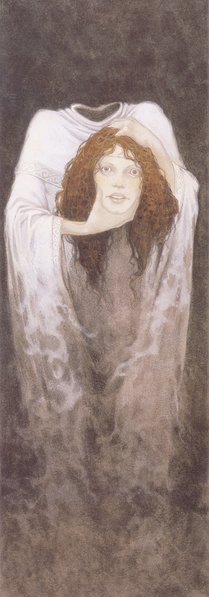or move on to Goddess Boann, next chronologically,
or use Her Cyclopedia Index
Bean-Sidhe, `Woman-of-the-Fairy-Mounds'.
BAN$E,
[to Whom the thirteenth day of April, day 103, is dedicated]


Geography/Culture: Celtic: Irish, probably Milesian.
Linguistic note: Although the usually given meaning is as above, bean, might mean `death' [quote from ety. of bane in Skeats] rather than `woman' and if, instead of interpreting sidhe with the popular meaning of fairy (because most people have forgotten that word's implication of divinity), it were translated as `Goddess', `Death-Goddess' could be an alternate meaning of Her name. Or, with bean accepted as meaning `woman', preferably `Queen' (it is cognate with Queen in its old form ... give quote), perhaps sidhe is related to shide meaning `billet of wood', or `cleft stick' [see Skeats], thereby rendering a meaning of `Queen-of-twigs', as though She were a writing-system Goddess, where the tree She represents is the death tree. However: "Among the Goidelic in Ireland and the Highlands of Scotland the fairies take their designation chiefly from a word síd, or síth (genitive síde or sída, of, or belonging to the síd), which may be of common origin with Latin sedes, `to sit', `where one settles', `settlement'. Eventually it signified the fairies themselves. Whence in Medieval Irish they were aes side, `fairies' that is `those who inhabit, or have settled in, the mounds', ben side, `female fairy', fer side, `male fairy'. Borrowed or suggested by Side, is the Welsh Sidi, as in Caer Sidi, `the Fortress of the Fairies'.
Description: Shapeshifting Fay Goddess; She Who appearing either as a beautiful weeping woman or as a gruesome Hag, foretells the death of Her viewer; White Lady of death; She Who has foreknowledge; She Whose nocturnal cries signify final doom to their over-hearer; She of the piercing voice; She Who is easily offended; She Who is associated with the tir nan og, `the Land of the Young'. She is usually associated with the Earth Goddess of Whose district She haunts. In multiple: Fate (ie: fairy) Goddesses; Daughters of the hill folk; the Little People; the Good People; Magicians; Those Who choose to bide their time for revenge in preference to fighting. They are sometimes conceived of as winged; usually small in stature, and often ugly, but sometimes tall and handsome. The oldest beings of the Irish mythological world.
To Whom are sacred: loon (whose nocturnal cry resembles, or is the same as, the cry of the Bean-sidhe); spider (their spinning); gossamer; mounds (in which the Bean-Sidhe live); pools and rivers (in which They are also believed to live).
Male equivalent: Fer-side, `Male-Fairy'.
Titles, Variants, etc.
Sources: Evans Wentz FFCC 25-8; Rhys CFWM 677-80 681; Walker WEMS 89.
Geography/Culture: Brittany.
Linguistic notes: bán, `fair', `white-haired', or ban, a prefix meaning `woman'. -drude has here been related to Greek dryad, originally refering to spirits of oak trees.
Description:Crone Goddess; She Who makes the final summons; Dryad of death.
Titles, Variants, etc.
Source: Walker WEMS 89.
Linguistic note: (sorcerers, cursers): The Irish word Corr may be identified with the Brythonic cor, `dwarf', though the better known meaning of corr in Irish is `crane, heron'. (I suppose I must have added this as a matter of possibly related interest).
Source: Rhys CFWM 681.